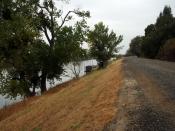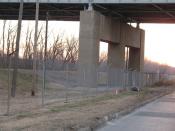Sacramento is a city surrounded by water, with both the Sacramento and the American Rivers running through it, as well as a vast array of levees. Many populated areas are above water only because the levees are holding back millions of gallons of water. The Sacramento levee system has been the target of great scrutiny in the aftermath of the hurricane Katrina, because levee failures caused much of the devastation in New Orleans. This examination brings up questions of whether or not the Sacramento levee system can be repaired, if development in the area should continue, and whether or not homeowners should be required to carry flood insurance.
The Sacramento levee system covers 2,600 miles and protects people in flood plain areas by holding back water from the Sacramento central valley region (Aston, 36). The levee system was built in the 1900's, primarily to protect 4 million acres of farmland.
It was not built to protect an entire city of 2 million, 500,000 of which are in flood plains (Aston, 36).
The Sacramento levee system is the second largest levee system in the nation, but it is in very poor repair. The Sacramento levee system is actually in worse repair than the New Orleans levees during Katrina, and has received a grade of "F" from The American Society of Civil Engineers (Ritter, 4A). Due to the weakness in the levee, certain regions have been deemed unsafe by the Army Corps of Engineers and FEMA. One of these regions is the Natomas area, which could be under 20 feet of water if the levees failed (Ritter, 4A).
There are many possible causes of flooding due to levee failure in Sacramento. An earthquake could cause the weak levees to collapse. "A big quake, say 6.5 on the Richter scale, would 'liquefy' the levees" (Aston, 36). A very long and wet winter, which would create a lot of snow in the nearby mountains, followed by a few warm spring days, and a strong spring storm, could produce more water than the levees could handle, causing flooding. Levee failure could also be caused by settling, seepage or tunneling rodents. "Levees are piles of dirt. They have a tendency to fail. If people are living behind levees, many feet below the water surface level, it is only a matter of time 'til some of them flood" (Kollars, 2005).
A levee failure in the Sacramento area could potentially cause great damage. The financial damage could be far greater than that in New Orleans, even though the loss of life would be less (Aston, 36), presumably due to being less densely populated. The American River alone would flood Arden, Cal Expo, and CSU Sacramento (figure 1), with damages in the millions of dollars. The Sacramento River would flood the Sacramento airport, Del Paso, and El Centro, just to name a few (figure 2). These areas include many single family developments. The homes are expensive and, although most have insurance, a high percentage of homeowners do not carry flood insurance. In fact, in Sacramento County as of 2004, only 15.4% of homes had flood insurance out of the 378,524 single family homes (Bernard). Since Katrina the number of homes with flood insurance has increased, but so has the number of homes in the area. Also, in most cases flood insurance in the Sacramento area would not be enough to cover losses. The most insurance you can buy is $250,000 for building damage and $100,000 for the contents of your home (Field, 36). Although this is sizeable, it is not nearly the price of a California home, so there would still be a financial loss. Flood insurance also does not cover the living costs while your home is being re-built (Field 36).
The logical course of action to prevent levee failure might seem to be repairing the levee system. The State of California approved a $5 billion loan to start repairs on the levees, but it is not enough. Although the repairs and reinforcement are better than nothing, the whole system needs to be re-done if we want to have true security from disaster. According to Jeff Mount, a geology professor at the University of California, Davis, all we are doing is "putting band-aids" on the levees when we really need to completely re-do the entire system (Ritter, 4A). Repairing the levee system is not really a viable option. It is not doing enough, and the risk of levee failure would still be too high.
Given the state of the Sacramento levees, and the scrutiny of the levee system after hurricane Katrina, it is no surprise that flood insurance rates have increased for existing homeowners in this region and that future construction has been halted in some areas (Ritter, 4A). However, halting construction in areas where there is already development, such as Natomas, does not seem to be a very practical idea since there are already homes in the area, and therefore the risk of loss already exists. Construction should be allowed to continue, if the homeowners purchase insurance for protection from a catastrophic flood. Although expensive for the homeowner, flood insurance forces them to have some measure of protection and it would be cheaper in the end if there was flooding. If the homeowner did not have flood insurance in the case of a flood, many would lose their homes as they could not afford to rebuild. This could be seen in New Orleans where some homeowners were paying the mortgage on their old home while trying to rebuild a new home. Many couldn't do this and lost everything. There is also an additional cost to the government when there is no flood insurance, as they must help those who can't help themselves due to lack of insurance. The federal government is requiring people who have federally backed loans to get flood insurance if they live in a flood-prone zone (Field, 65), and this should be extended requiring flood insurance on all loans in a zone like Natomas. In areas where there is no development, unlike Natomas, construction should be halted unless FEMA says there is necessary flood protection. Halting construction in non-developed areas is reasonable because it doesn't add additional risk of loss in case of flood, and doesn't cause developers to lose out on existing development. .
Katrina taught us a lesson which Sacramento and the rest of the world should study and learn from. The levee system in Sacramento is the second largest levee system in the nation, protecting people and property, but it is in poor condition. Everybody saw the destruction wrought by the levees collapsing in New Orleans, which was in better repair than the Sacramento levee system. Flood insurance offers some protection from the results of levee failure, but it does not cover all costs, and the majority of homeowners do not have flood insurance. The government should allot more resources to building a new levee system instead of just repairing the old system. Billions of dollars spent today would save tens of billions of dollars, as well as lives, in a flood's aftermath.
Works CitiedAston, Adam, Michael Arndt, and Tom Sawyer. "IF THE LEVEES FAIL IN CALIFORNIA..." Business week .4047 (2007):36-.
Bernard, Thomas. "NATIONAL FLOOD INSURANCE PROGRAM." Insurance Information Institute. 01 Jan 2006. III Media. 17 Oct 2007 .
Brinkley, Douglas. "Reckless Abandonment." The Washington Post. 26 Aug 2007. The Washington Post Company. 17 Oct 2007 .
Field, Anne. "WHY YOU COULD SOON BE IN A FLOOD ZONE." Business Week 4066(2008): 65.
Kollars, Deb. "Tempting Fate." SacBee. 30 Oct 2005. Sacramento Bee. 18 Oct 2007 .
Kollars, Deb . "Sacramento's flood peril is highest in U.S. ." Sac Bee. 30 Oct 2005. Sacramento Bee. 18 Oct 2007 .
Ritter, John. "California races to repair levee system." USA TODAY November 27(2006 ): 4A.
"Storm Ready: Flood Depth and Evacuation Plan Maps." Sacrameto County Department of Water Resources. 18 Apr 2008 .
Wolk, Lois. "Flood Liability Agenda." California State Assembly. 25. Oct 2005. California State Assembly. 17 Oct 2007 .





